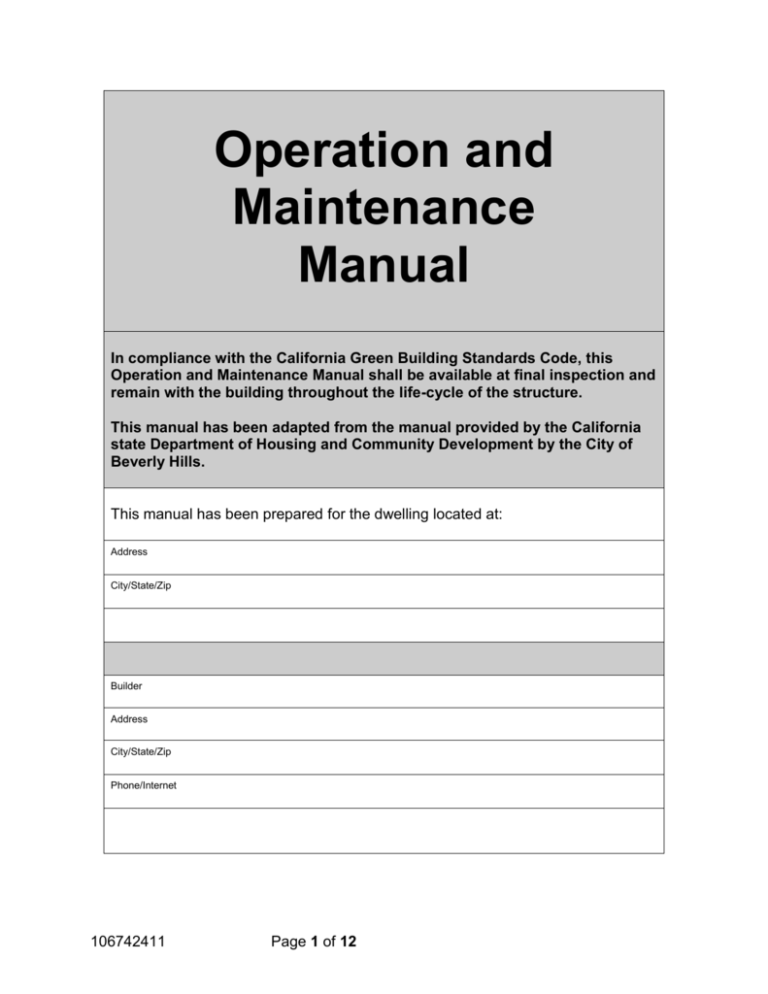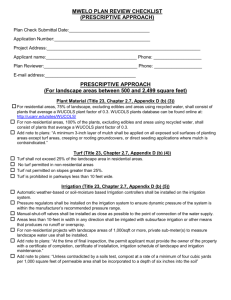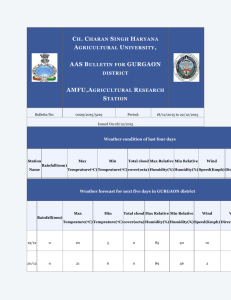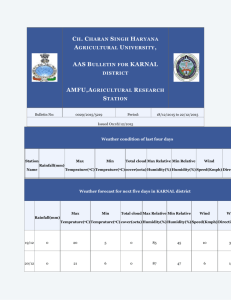OMM-1 - City Of Beverly Hills
advertisement

Operation and Maintenance Manual In compliance with the California Green Building Standards Code, this Operation and Maintenance Manual shall be available at final inspection and remain with the building throughout the life-cycle of the structure. This manual has been adapted from the manual provided by the California state Department of Housing and Community Development by the City of Beverly Hills. This manual has been prepared for the dwelling located at: Address City/State/Zip Builder Address City/State/Zip Phone/Internet 106742411 Page 1 of 12 Electricity for this property is provided by: □ Check if solar or alternate source of electricity is used. Service Provider Southern California Edison Address P.O. Box 800 City/State/Zip Rosemead, CA, 91770 Phone/Internet 1-800-655-4555 / www.sce.com Alternate Source *Information to reduce use of electricity is included. Water for this property is provided by: □ Check if well or alternate source of water is used. Service Provider City of Beverly Hills Department of Public Works Water Service Address 345 Foothill Road City/State/Zip Beverly Hills, CA 90210 Phone/Internet (310) 285-2467 / www.beverlyhills.org *Information to reduce consumption of water is included. *NOTE: The provider of this manual is required to supply information from local utility, water and waste recovery providers on methods to further reduce resource consumption, including recycle programs and locations. 106742411 Page 2 of 12 Sewer for this property is provided by: □ Check if private sewage disposal/septic is used. Service Provider City of Beverly Hills Department of Public Works Water Service Address 345 Foothill Road City/State/Zip Beverly Hills, CA 90210 Phone/Internet (310) 285-2467 / www.beverlyhills.org *Information to reduce demand on sewage system is included. Fuel Gas for this property is provided by: □ Check if Liquid Propane tank is used. Service Provider Southern California Gas Company Address PO Box 3150 City/State/Zip San Dimas, CA, 91773 Phone/Internet (800) 427-2200 / www.socalgas.com *Information to reduce consumption of fuel gas is included. *NOTE: The provider of this manual is required to supply information from local utility, water and waste recovery providers on methods to further reduce resource consumption, including recycle programs and locations. 106742411 Page 3 of 12 Garbage/Trash removal for this property is provided by: Service Provider City of Beverly Hills Department of Public Works Address 345 Foothill Road City/State/Zip Beverly Hills, CA 90210 Phone/Internet (310) 285-2467 / www.beverlyhills.org *Information on waste reduction is included. Recycling for this property is provided by: Service Provider City of Beverly Hills Department of Public Works Address 345 Foothill Road City/State/Zip Beverly Hills, CA 90210 Phone/Internet (310) 285-2467 / www.beverlyhills.org *Information about local recycling programs and their locations is included. *NOTE: The provider of this manual is required to supply information from local utility, water and waste recovery providers on methods to further reduce resource consumption, including recycle programs and locations. 106742411 Page 4 of 12 Public Transportation Regional and local public transportation options, including address, phone and web addresses are provided below. Bus line Phone/Internet Light Rail/Train Phone/Internet Car Pool/Van Pool Phone/Internet Ride Share or Other Building Department Occupancy of this dwelling was authorized by the local enforcing agency. Local Enforcing Agency City of Beverly Hills Building and Safety Division Address 455 N. Rexford Dr. City/State/Zip Beverly Hills, CA 90210 Phone/Internet (310) 285-1141 / www.beverlyhills.org/buildingandsafety 106742411 Page 5 of 12 Special Inspection Verification/Certification Special inspection required by the CALGreen code or by the local enforcing agency shall be verified. Upon completion, a copy of inspection verification and/or certificates of completion shall be included in this manual. ● ● ● ● ● ● ● ● ● HVAC system commissioning HERS Verification Cool roof verification Material conservation Blower door testing Attic Insulation Thermal insulation Cement reduction Other third party requirements Note: The above listed items are not all-inclusive measures that may need “Special Inspection.” Check with the local enforcing agency to verify mandated special inspections and verification requirements. Fill in any other verifications or certifications below: 106742411 Page 6 of 12 Solar Incentive Programs California Programs Information about state renewable energy incentive programs, such as the California Solar Initiative, is available through the California Energy Commission or through Go Solar California at the websites below. http://www.energy.ca.gov/ http://gosolarcalifornia.ca.gov Other Programs Contact your local government or public utility (provided previously in this manual) for more information regarding energy conservation tips, strategies and public/private partnerships that promote enhanced sustainability and/or save money. Tax breaks, including rebates, credits or discounts may also be available through the local government, public utilities or the Federal Government, US Department of Energy. The U.S. Department of Energy website: http://www.energy.gov/yourhome.htm Water Conserving Landscape To comply with the California Green Building Standards Code, automatic irrigation system controllers for landscaping installed at the time of final inspection must be weather- or soil moisture-based. Irrigation Controllers There are several types of irrigation controllers that base the irrigation schedule on evapotranspiration data. Other irrigation controllers may use a combination of historical data and real-time data feeds from on-site temperature sensors, soil moisture sensors, sunlight intensity indicators or they may use data from weather stations. Weather and/or soil moisture- based controllers represent technological advances in irrigation that enable the proper amount of water required by the landscape plants or postpone irrigation during periods of rain. Utilizing these "smart" controllers is an improvement over irrigating by an arbitrary "run time" where the amount of water needed and the amount of water applied may not be effectively matched. 106742411 Page 7 of 12 Landscape Water Use Conservation Methods There are many methods to reduce the amount of water used in a landscape and still maintain the health, appearance and function of the landscape. Following are a few examples: Conform to local or the California Department of Water Resources' model Water Efficient Landscape Ordinance. Use water-efficient landscape designs utilizing native and drought tolerant plants and minimize turf areas. Use mulch, soil amendments or other soil improvement methods to reduce water loss through evaporation or runoff and to improve water availability for plant use. Install efficient irrigation systems and follow a regular maintenance schedule. Adjust irrigation controllers as necessary to accommodate changes in seasons and plant needs. Schedule landscape irrigation during early or late hours. Stay current on new technologies, strategies or products that promote efficient water use. Irrigation System Design Homeowners or a design professional can develop an efficient system design meeting homeowner expectations while also reducing waste and conserving natural resources. When planning landscaping and irrigation, the following ideas can help: Design irrigation systems to be consistent with hydrozones (areas of plants with similar water needs.) Minimize the usage of spray heads. Install a low consumption irrigation system such as drip or subsurface. Use graywater or recycled water when possible. Consider rainwater catchment and storage systems. Follow the manufacturer’s installation instructions to ensure optimum system efficiency. 106742411 Page 8 of 12 Operation and Maintenance Information This property and structure require periodic maintenance of the grounds, equipment and appliances. Manufacturer installation, operation and maintenance instructions must be followed for all equipment and appliances. Examples of these manuals include, but are not limited to: HVAC system Water heater Water saving devices and water reuse systems Water pump and/or well Water treatment system Kitchen appliances Garage door and opener Whole house fan Security alarm system Smoke, fire and carbon monoxide alarms Landscape irrigation system Photovoltaic electrical system Septic system Included or attached to this manual are the installation and maintenance instructions provided by the manufacturer for each specific appliance and/or equipment installed. 106742411 Page 9 of 12 Checklist Proper maintenance will extend the life of a building and the systems installed therein. In addition to specific manufacturer instructions for maintenance and service, the following checklist will assist setting a typical maintenance schedule required for a building. Weekly Survey the property, check overall condition Check landscape irrigation system for leaks and broken heads Check exterior lighting for burned out bulbs Monthly Change return air filters Check caulking: exterior and interior at plumbing fixtures and at floors (tub, toilet, etc.) Check exterior drainage and swales Check exhaust fan and damper door for correct operation Dust off and test smoke and carbon monoxide detectors for operation Check plumbing for leaks (bathtubs, dishwasher, sinks, lavatories, showers, laundry hook ups, water heater, toilets and any other plumbing) Check plants and shrubs – trim to avoid contact with house Check irrigation sprinklers and adjust as necessary – avoid water spray on building and ensure uniform coverage Test ground fault circuit interrupter (GFCI) outlets Semi-Annually Check clothes dryer vent pipe and remove any lint Clean out roof gutters and downspouts Inspect roof system for broken or missing roofing material Check and clean window weep holes Check weather stripping Check outdoor AC condenser unit for obstructions and/or debris, clean unit per manufacturer’s recommendation for optimal performance Check house for evidence of termites and other pests Check all painted surfaces Drain water heater to remove sediment Annually Change batteries in smoke detectors and carbon monoxide devices Check condensate drain lines for blockage Trim trees to avoid contact with house and obstruction of solar panels Check chimney flue and vents for obstructions and debris 106742411 Page 10 of 12 Portions of this Property will Require Routine Maintenance for which There May Not Be a Specific Manual Grading The grading around the building is sloped away from the structure, which is not only functional, but a building code requirement enforced during the final inspection. The yard drainage must not drain onto neighboring property or near the building foundation. It is important the owner or tenant maintain this grade or swale to protect the building from moisture. An inspection after any landscaping, construction or a storm is necessary so the swale or grade always directs the flow of water away from the foundation of the building and to storm sewer systems or other appropriate locations approved for the structure. Gutters The gutter and downspouts will need periodic maintenance to ensure proper function. The required interval for this maintenance will vary by season; however, gutters and downspouts should be inspected for debris before the rainy season. When trees and other deciduous vegetation shed leaves that drop into the gutters, this will inhibit the flow of water and possibly clog downspouts. The leaves and/or debris must be removed in order for the system to work as designed. The downspouts should direct the storm water away from the foundation at least 5 feet to avoid damage to the structure. Always keep the area clear where the storm water flows out of the downspout. If a clear area is not possible, subsurface drains may need to be installed. Irrigation Inspect the landscape irrigation systems weekly for leaking or broken heads. Frost-Protected Foundation Systems When the building utilizes a Frost-Protected Shallow Foundation, as allowed by local conditions, the monthly mean temperature of the building must be maintained at a minimum of 64°F (18°C). Relative Humidity (RH) RH is the percent of moisture in the air compared to the maximum amount of moisture this air can hold at the same condition. Warm air will hold more moisture than cold air. The design of the HVAC system should include controlling the moisture levels appropriate to the climate. The addition of moisture (humidification) may be required in colder climates during the winter season and removed (dehumidification) during the summer months. Automatic, computer controlled humidifiers can control the humidity levels, providing enough moisture for a healthy comfortable dwelling and within the limits to prevent window and cold surface condensation. These levels are usually between 30 to 60 percent RH although certain health conditions may dictate benefits at either the higher or lower ranges. 106742411 Page 11 of 12 Hygrometer The hygrometer will show RH. Although the RH will not be exactly the same throughout the structure, one hygrometer is usually sufficient. It should be placed where the humidity symptoms are most obvious (e.g., in the room that you are most concerned about.) Low Relative Humidity Below 30 percent RH, people can be uncomfortable and can suffer from dry mucus membranes, which can lead to nosebleeds and infections. In general, low RH is only a problem during the winter months when the outside air contains very little moisture. It is this dry outside air entering through cracks and openings in the building shell that causes the inside air to become dry. The greater the amount of outside air that leaks into the building, the dryer the indoor air becomes. By air-sealing and using energyefficient construction, uncontrolled air leakage is greatly reduced, a more controlled indoor environment is created, and RH can be maintained at acceptable levels without the use of a humidifier. Humidifiers require maintenance to avoid becoming breeding grounds for biological contaminants. The effects of bacteria, viruses, fungi, respiratory infections, allergic rhinitis, asthma, and ozone production can be minimized by higher humidity levels. Studies have shown that wintertime operation at 68° F at 70% RH provides the same level of occupant comfort as does 72° F at 30% RH. Lower utility bills and a healthier environment are both benefits of controlled RH. High Relative Humidity High RH can lead to occupant discomfort, annoyances, and possibly serious health issues as they relate to bacteria, viruses, fungi, mites (dust mites and mold), allergic rhinitis, asthma, and chemical interactions with mold, dust mites, and other biological pollutants. The air conditioning system and/or stand-alone dehumidifier are designed to remove moisture (latent load) and decrease the RH levels. Studies show that summertime operation at 78° F at 30% RH provides the same level of occupant comfort as does 74° F at 70% RH. The lower humidity level will provide increased comfort, lower utility bills and lessen the risk of health issues associated with high humidity. Using exhaust fans in the bathrooms and kitchen can remove much of the moisture that builds up from everyday activities and help keep RH below 50%. Having a humidistat connected to an exhaust fan is required in bathrooms. This is an effective way to control RH in moisture prone areas. When using an adjustable humidistat, the setting should be adjusted according to the season: lower RH in the summer and higher RH in the winter. Another benefit to using kitchen and bathroom exhaust fans is removal of odors and pollutants. These fans can also be part of an active whole house ventilation system for the entire house and help to reduce humidity levels. 106742411 Page 12 of 12








